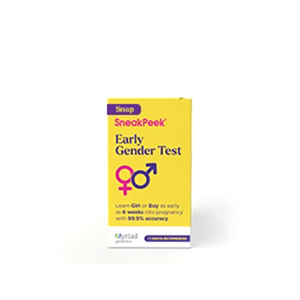Published on August 25th, 2023 and Updated on January 15th, 2024
Check out SneakPeek Gender Test to find out your baby’s gender as early as 6 weeks at over 99% accuracy1!
Ideally, an at-home pregnancy test will confirm that your family growth goals are coming to fruition—but are tests 100% reliable, 100% of the time? Not always.
Despite their 99% efficacy rate when used as instructed, at-home pregnancy tests can be wrong. If your intuition is telling you you’re pregnant, but a test tells you otherwise, you may have a false negative on your hands. In very rare cases, twin pregnancies can yield a false negative, the result of what’s known as “the high dose hook effect,” or simply “the hook effect.”
Whether you’re indeed pregnant or still trying for a baby, understanding the science behind false negatives can help you understand your body—and, if your intuition is correct, your pregnancy—better. Below, we clarify everything you need to know about the hook effect and how to take a pregnancy test to ensure the most accurate reading possible.
Understanding the Hook Effect
There are plenty of cases where too much of a good thing can lead to less-than-desirable results. If you’re trying to get pregnant, the same principle can extend to hCG—human chorionic gonadotropin. This is the key hormone your body churns out when you’ve recently conceived, and it’s also the pregnancy hormone both at-home and provider-administered pregnancy tests are designed to screen for.
Though it’s not universal, women who are carrying twins or multiples may have more hCG in their system than women who are pregnant with singles. And, in exceptional cases, having too much hCG in your urine or blood can throw pregnancy test results out of whack. Both at-home tests and lab tests administered by a healthcare provider can be subject to this error.
So, can twins cause false negative pregnancy test?
Put simply, yes. When too much of a certain chemical is present, the tools used to screen for them can become overwhelmed and may not deliver an accurate result. In some scenarios, even women carrying multiples who are as far along as their third trimester can receive a negative test result on labs despite being incontrovertibly pregnant!
How do twin pregnancies differ from single pregnancies?
Importantly, some studies have shown that twin and singleton pregnancies don’t always differ in hCG volume. HCG volume alone isn’t considered a fool-proof metric for determining how many babies you’re carrying.
That said, it’s worth noting that some women who are pregnant with twins notice symptoms in early pregnancy that may indicate their body is putting in extra work to grow two new babies. These pregnancy symptoms include:
- Excessive fatigue
- Excessive nausea or vomiting
- Early weight gain
Moreover, here are some factors that make it more likely to conceive twins:
- Your family has a history of carrying multiple twin pregnancies
- You’re growing your family with the help of assisted reproductive technologies (ART) such as in-vitro fertilization (IVF)
- You’re an older mom, as age can cause your body to release more than one egg at a time (hyperovulation)
If you suspect you are having twin pregnancy and are seeing signs of twin pregnancy, it’s best to confirm with a healthcare provider, who can let you know by administering an ultrasound.
Being pregnant with multiples is considered riskier for moms and may be more physically demanding for many women—particularly if you’ve never been pregnant before! Your healthcare provider will monitor your pregnancy more closely to ensure both babies are developing well. The earlier you can find out how many you’re carrying, the easier it may be to prepare for the months ahead.
Other Factors That Can Cause a Negative Test Result
It’s crucial to understand that this fluke is a result of mechanical error, rather than any fault of your body’s. That said, receiving a false negative isn’t always linked to who (or the number of “who”s) taking up residence in your belly.
Inaccurate pregnancy test results may also occur under the following circumstances.
Taking the Test Too Early
If you’re eager to start growing your family, it’s tempting to take a pregnancy test as soon as you think you might be pregnant. But for your own peace of mind—and improved test result accuracy—it’s best to wait until you’ve missed a period to take a test.
For most women, the earliest time to take a test that yields accurate results is around 14 DPO (days past ovulation). This milestone usually lines up with when you’d normally expect your next period.
Ectopic Pregnancy
Ectopic pregnancy refers to a condition where a fertilized egg embeds outside of the uterus, like in the fallopian tubes. Misplaced implantation can inhibit the body’s production of hCG hormone, which means the pregnancy may not be confirmed by a test—even if the embryo continues to develop.
Ectopic pregnancies are non-viable and are considered a serious health condition that requires emergency clinical intervention to remove the egg from your body. The following symptoms may be a sign of ectopic pregnancy:
- Lower abdominal, pelvic, or lower back pain
- Shoulder pain
- Bleeding
- Feeling dizzy, weak, or light-headed
- Losing consciousness
Ectopic pregnancies are more likely in women 35 and older. If you have been trying for a baby and experience any of these symptoms, it’s important to notify and visit a healthcare provider immediately. While ectopic pregnancies can be emotionally difficult and require surgery to remove, it is possible to recover and try to get pregnant again once you’ve healed.
Molar Pregnancy
While rare, molar pregnancies may also show up as a false negative on a pregnancy test. Clinicians refer to molar pregnancies as gestational trophoblastic disease (GTD), which can cause extremely high levels of hCG to flood the body. The condition occurs when a tumor develops on an embryo, which usually renders the pregnancy non-viable, resulting in pregnancy loss.
A molar pregnancy may present with the following early signs:
- Severe nausea and vomiting
- Vaginal bleeding
- Pelvic pain or a feeling of pressure
- Cysts passed through the vagina
If you experience any of these symptoms, it’s important to reach out to a healthcare provider immediately for surgical removal and treatment. Fortunately, it’s unusual for GTD to recur, and plenty of women still have a good chance of getting pregnant if they have one. That said, your healthcare provider may encourage you to wait for up to a year before trying again.
Irregular Menstrual Cycles
Up to ¼ of reproductive-aged women in the US are estimated to have menstrual irregularities. The condition can take several forms, from skipped periods for a few months at a time (amenorrhea) to fluctuating cycle lengths throughout the year.
Menstrual irregularities may be caused by:
- Being under excessive or chronic stress
- Significant weight gain or loss
- Switching or retiring use of hormonal birth control
- Polycystic ovarian syndrome (PCOS)
- Endometriosis
- Pelvic inflammatory disease (PID)
- Thyroid conditions
If you experience menstrual irregularities, it could be a sign that your ovulation also occurs on an irregular schedule. This can make planning a pregnancy more challenging by making it harder to predict your fertile windows. Working with a fertility specialist or healthcare provider may help strengthen your chances of conception.
Tips for Using an At-Home Pregnancy Test for Accurate Results
When you’re trying for a baby or are seeing symptoms of early pregnancy, ensuring an accurate pregnancy test result can help put your mind at ease. To get the most accurate results possible, try implementing the following guidelines:
- Track your periods – Familiarizing yourself with your reproductive rhythms is key for timing your conception efforts successfully. Tracking your periods can also inform you of any irregularities you may be experiencing that could be complicating your efforts.
- Take the test in the morning – More hCG hormone, if present, tends to present in urine collected first thing in the morning.
- Avoid drinking too many fluids – Excessive water or fluid in your body may dilute compounds in the urine (aka hCG) that pregnancy tests screen for. If you take a test later in the day, aim to keep fluid consumption to a minimum.
- Follow instructions closely – Most at-home pregnancy tests work fairly similarly, but different brands may have different instructions in timing and urine collection methods. So, even if you’ve taken a urine pregnancy test before, be sure to read the included instructions to promote accuracy.
- Double-check your results – Most store-bought pregnancy tests come in packs of two—an excellent opportunity to double your chances for accurate results! This is especially helpful if your initial test results seem incorrect or are hard to read.
Prepare for Pregnancy Earlier with SneakPeek
If you’re looking for concrete results you can trust during your pregnancy journey, check out SneakPeek’s Early Gender Blood Test.
With this DNA-based at-home test, you can discover your baby’s gender as early as 6 weeks into your pregnancy with over 99% clinically proven accuracy1—that’s even more accurate than a pregnancy test! You’ll take your sample from home, mail it to SneakPeek labs, and we’ll triple-review your results and send them back on the same day they’re received. We’ll even send you a complimentary downloadable report you can share with your healthcare provider.
SneakPeek is OBGYN’s #1 recommended at-home early gender test, used by more than 1 million expecting mothers around the country. To get answers you can trust about your future baby, visit SneakPeek today.
Sources:
- Cleveland Clinic. Pregnancy Tests. https://my.clevelandclinic.org/health/articles/9703-pregnancy-tests
- National Library of Medicine. First trimester β-hCG and estradiol levels in singleton and twin pregnancies after assisted reproduction. https://pubmed.ncbi.nlm.nih.gov/28753549/
- Healthline. Is the ‘Hook Effect’ Messing Up My Home Pregnancy Test? https://www.healthline.com/health/pregnancy/hook-effect#the-effect-explained
- Healthline. Do High hCG Levels Mean You’re Pregnant with Twins? https://www.healthline.com/health/pregnancy/hcg-levels-twins
- Mayo Clinic. Twin pregnancy: What twins or multiples mean for mom. https://www.mayoclinic.org/healthy-lifestyle/pregnancy-week-by-week/in-depth/twin-pregnancy/art-20048161
- Cleveland Clinic. Twin Pregnancy. https://my.clevelandclinic.org/health/articles/23158-twin-pregnancy
- Healthline. What to Expect at 14 DPO. https://www.healthline.com/health/pregnancy/14-dpo
- VeryWell Familiy. Can a Negative Pregnancy Test Be Wrong? https://www.verywellfamily.com/missed-period-but-negative-pregnancy-test-1959885
- Cleveland Clinic. Ectopic Pregnancy. https://my.clevelandclinic.org/health/diseases/9687-ectopic-pregnancy#symptoms-and-causes
- Mayo Clinic. Molar pregnancy. https://www.mayoclinic.org/diseases-conditions/molar-pregnancy/symptoms-causes/syc-20375175
- Cleveland Clinic. Irregular Periods. https://my.clevelandclinic.org/health/diseases/14633-abnormal-menstruation-periods
- VeryWell Family. Tips for Taking a Pregnancy Test. https://www.verywellfamily.com/how-to-take-pregnancy-test-tips-2759713

Shop Our Products
SneakPeek aims to provide the most accurate and up-to-date information to help our readers make informed decisions regarding their health before, during, and after pregnancy. This article was written based upon trusted scientific research studies and/or articles. Credible information sources for this article are cited and hyperlinked.





